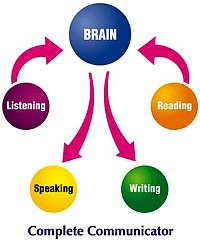 |
Learn English Locally, Apply It Worldwide! Enjoy Regular Practice |
Communicative Grammar or Traditional?
Communicative grammar puts the accent on the actual act of communication. It gives the speaker all the tools for an effective transmission of the intended message. How does it work?
In traditional grammar the words are categorised into parts of speech, which you combine in sentences, by following certain rigid rules.
Here are the lessons we covered in our English Corner E-zine so far.
|
Grammar vs. communication You study grammar so that you know how to create your sentences/messages correctly. Other people understand you because they master the same set of rules which is the grammar you're both sharing. When we look at grammar from the point of view of the speaker and what it is that s/he wants to communicate and how the message is put across, we call it communicative grammar. The message and the act of communication is more important than the grammar. However, you couldn't say it without knowing the traditional grammar you've been studying, because this is the common denominator between you, the speaker and the person receiving your message, the listener. Grammar and pronunciation are only there to help us say what we want to say correctly, so that the recipient of our message understands us with no problems. |
Grammar exists only to help your communication Hm! Let's see - when do native speakers communicate about their thoughts, feelings, events and problems... before or after they 'know' their grammar? ... Precisely! When did you start to speak in your language? It's the same with English: if you don't speak it, you can't learn it. In spite of you being busy learning it nevertheless, why bother? You don't use it anyway! The bottom line is that we must communicate. It's the only radar for how well we're learnng a language, so... get rid of the shyness and let's get on with it. When you know 5 words, speak them! When you know 20 words, speak! And again, when you know 100, 1000, etc. One spoken word attracts the next one... |
Rule 1 = start speaking! - Rule 2 = never stop!
Note to teachers of English:
Based on the
communicative grammar approach to the teaching of second/foreign
languages, language structures are not supposed to be taught in
isolation but integrated to the four skills of language: listening, speaking, reading and writing.
Try to always have your students practice a structure both orally and
in written form. The students must understand a grammatical structure
and be able to use it in a variety of situations spontaneously and not
just learn the grammatical patterns at the utterance level.
The approach calls for a certain balance between pre-communicative and communicative activities: the first prepare the learner to handle the language rules for actual communication and the latter enable him to use the structures in real communication. The students must not only do drills and pre-communicative exercises in class, but they should also interact and communicate with other speakers, outside the classroom environment, where they would have a chance to use the patterns they are studying. If this is not possible, an alternative could be to plan the classes in a way so that the students use the structures naturally and not artificially, for example in dialogues and role play.
English Corner Weekly E-zine
Packed with knowledge, published on Tuesdays.
Get yours here!
Our Archives:
Our lessons in the names and sounds of letters, short & long vowel sounds, CVCs, CCVCs, CVCCs, sight words, vowel and consonant contrasts, etc.
Our lessons will help increase your vocabulary, word recognition, find meaning in context, skills for TOEFL tests and other games, for fun.
Here we shall build some lessons to help you improve your writing skills.
Lots of lessons: cause & effect, comparisons, linking signals, relative clauses, presenting information, expressing emotions and grammar games, of course. We had more lessons on: intensifying adverbs and phrasal verbs, expressing various concepts such as addition, exception, restriction and ambiguity. Lately we started some exercises: likes/dislikes, frequency adverbs (twice), verb tenses, etc.
Learn how to build a website, by using the SBI! system - start from the basics, developing a site concept and a niche, supply and demand, learn about profitability and monetization, payment processing, register domain, website structure and content as a pyramid. Also learn about the tools I'm using to build this website. We also covered how to build traffic, working with search engines, building a good system of inbound links, using social marketing and blogs with the SBI system, how to use Socialize It and Form Build It, how to publish an e-zine and how to build a social network in your niche.
We looked at a few games by now: Countable & uncountable nouns, Free Rice, Name That Thing, Spell It, Spelloween, the Phrasal Verbs Game, Preposition Desert, The Sentence Game, Word Confusion, Word Wangling, Buzzing Bees, and The Verb Viper Game.
Be prepared to play and learn more pretty soon.
